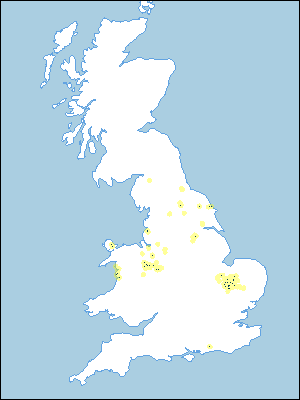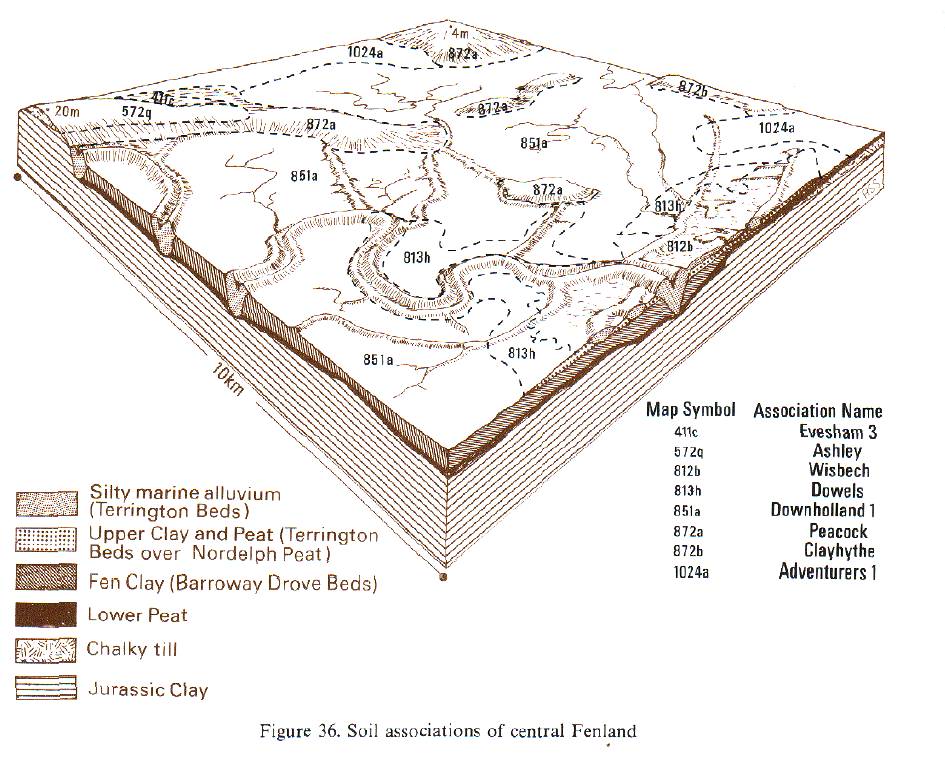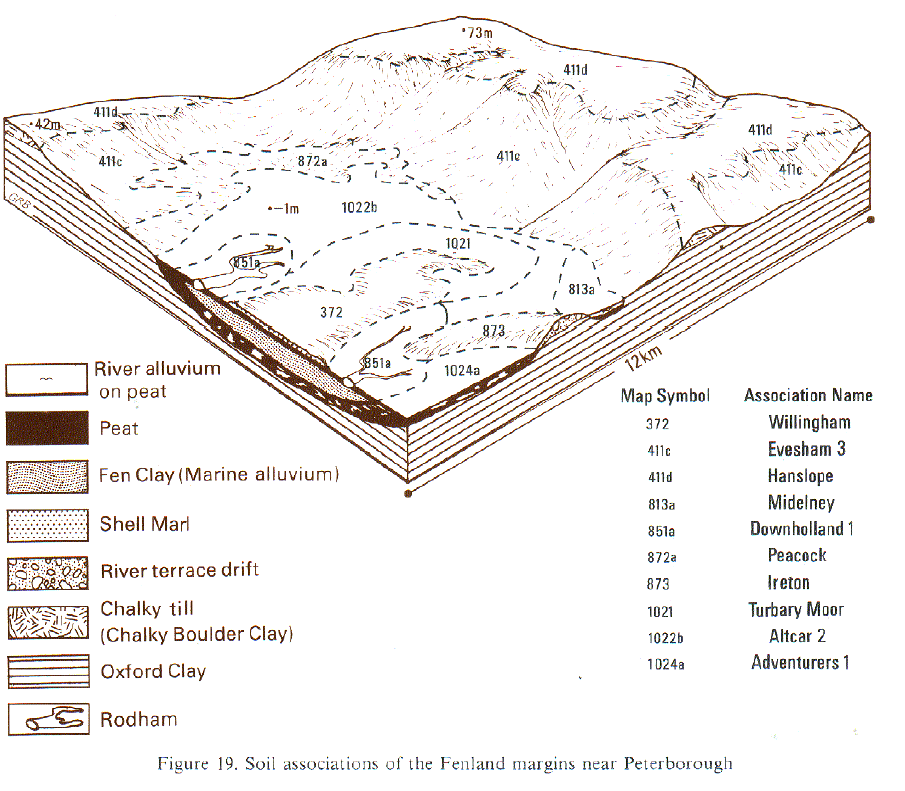
Soil Associations
1024a ADVENTURERS' 1
Soil and site characteristics
Deep peat soils. Flat land. Groundwater levels often controlled by ditches and pumps, some undrained areas. Risk of wind erosion.
Geology
Fen peat
Cropping and Land Use
Cereals, sugar beet, potatoes and field vegetables; some cereals in the Northern Region; rough grazing in wetland habitats.
Component soil series
| Subgroup | Series name | Percentage | WRB 2006 link |
|---|---|---|---|
| 10.24 | ADVENTURERS' | 70% | Drainic Rheic Sapric Histosols |
| 10.22 | ALTCAR | 30% | Drainic Rheic Fibric Histosols |
Covers 290 km2 in England and Wales
Soilscapes Classification
| 27 |
Fen peat soils |
1024a ADVENTURERS' 1
Detailed Description
This association comprises amorphous and semi-fibrous peat soils formed mainly in reed and sedge peat, often with wood fragments from carr. The most widespread soil is Adventurers' series, earthy eutro-amorphous peat soils, in which the subsoils are predominantly humified peat and contain few identifiable plant remains. The locally important Altcar series, earthy eu-fibrous peat soils, is less humified and its subsoils are mainly semi-fibrous or fibrous, with abundant recognizable plant material. Both series have well decomposed organic topsoils.
The association covers 308 km² mainly in the south of the Fens, but it is scattered widely elsewhere in England and Wales. In Northern England it occurs mainly east of the Pennines and otherwise in glaciated morainic landscape near Wem in Shropshire and in south-west Lancashire and Cheshire. In Wales it occurs on Anglesey and in valleys bordering Cardigan Bay. There is a small area in the Arun valley in West Sussex. The land is flat and permanently waterlogged in its natural state. It is now often ditched, without hedges, and generally has few trees. In the Fens, at or slightly below sea level, and in other similar sites in England, water-tables are controlled by pumping and the land is in arable cultivation. Elsewhere, drainage is mainly by gravity, its effectiveness depending on the gradient and clean maintenance of outfalls. Where drainage is efficient and the climate is sufficiently dry the land is cultivated but much in Wales is under grass.
The association is widely distributed in Shropshire, covering 76 km², mainly west of Wem bordering the rivers Perry and Roden and north of Telford. There are scattered small areas in Cheshire north-east of Malpas, near Chester and Congleton. Here it occurs mainly in narrow strips adjacent to rivers or in small depressions of glacial origin. The peat, often with wood remains, is mixed with mineral matter brought in by flooding streams. Small areas of Sphagnum peat also occur. Altcar soils are nearly as extensive as those of the Adventurers' series and in both, the depth of peat ranges from 40 to about 370 cm. Below 60 cm depth it is generally semi-fibrous or fibrous, but well-humified peat can be found at greater depths. The soils vary in acidity. Acid semi-fibrous Ridley soils and, at the margins of the various parcels, alluvial soils of the Wensum, Sulham and Midelney series also occur as well as sandy Isleham series. In Lancashire the association covers 9 km² inland from Southport where it was originally mapped as Martin Mere complex (Crompton 1966). Here the soils contain more mineral matter than is usual. The peat, though generally less than 120 cm thick, exceeds 3 m in places (Hall and Folland 1967). The low-lying land needs systematic pump drainage before it can be cultivated. Martin Mere has been effectively drained by pumps since the mid-nineteenth century, though a small reedswamp, now a nature reserve, survives. Only the central part of the former mere, at 1 to 2 m O.D., needs pump drainage, as the margins are 2 to 6 m O.D. In South East England it is found at Amberley Wild Brooks in the Arun valley where it includes some clayey alluvial soils of the Fladbury series.
These soils cover 160 km² in the Fens in Cambridgeshire, Norfolk and Suffolk. North of Cambridge they flank the Cam and Great Ouse as far as Ely, and occur around the Isle of Ely. In the east they are found where the rivers Lark, Little Ouse and Wissey flow into the Fenland and also occur near Hilgay, south-east of March, at Ramsey, and near Whittlesey. They occur too in the Hundred Foot Washes between the embankments of the man-made Bedford Rivers and are found in similar washes along the Nene east of Whittlesey. This dispersed distribution results from wastage of the former peat cover since effective drainage in the mid-seventeenth century. Thick peat is now confined to undrained areas and to the margins of the Fens. The proportion of Altcar series varies but is never large. The strongly acid Mendham series occurs locally and is common west of Ely, often where the peat is less than 80 cm thick. Where Mendham series and acid Adventurers' soils are iron-rich they have "drummy" layers with hard blocky structures, which are not easily rewetted after drying. The Adventurer's series often includes thin layers of white shell mar1 deposited in former pools, especially between Cambridge, Ely, Welney and Feltwell where the groundwater is fed from the Chalk. The pH of Adventurers' soils thus varies from less than 4.0 to mote than 7.0 and locally the peat is over 5 m thick.
There are 27 km² of this association in North Yorkshire. Part is at the east end of The Carrs in the Vale of Pickering, bordering the straightened and embanked river Hertford into which drainage water from the adjoining fields is pumped. Here the Adventurers' series is only slightly more extensive than the Altcar series, and sandy Isleham and Blackwood soils also occur. South-west of Northallerton, basins with Adventurers' soils north and south of Bedale drain to the river Swale. In Durham there are two parcels of land totalling 5 km² in depressions near Newton Aycliffe drained by the river Skerne. By the river Tome south of Doncaster, and on West Moor, Armthorpe, the soils were originally mapped as Altcar series. Here the proportions of Adventurers' and Altcar soils are similar to those in the Vale of Pickering. Near the Tome there are also some Blackwood and Oldcotes soils. The latter consist of amorphous peat 40 cm or more thick resting on white algal marl or tufa. Colthrop soils also occur. Smaller areas of the association are also found near Pickering, Carlisle, Boroughbridge and at Grassington in Wharfedale, the last being at 190 m O.D.
Soil Water Regime
With good groundwater control the soils are well drained (Wetness Class I). Both main series are excellent, easily worked, water-retentive soils, which are non-droughty for all crops including grass though seasonal wetness can interfere with cultivation and harvesting. Where arterial drainage is fully effective the soils are practically never waterlogged but where undrained they are severely or more or less permanently waterlogged (Wetness Class V or VI). In Wales Drainage is effected by gravity through pipes and ditches and is of varying efficiency. In Anglesey drainage schemes have been largely unsuccessful because outlets are either dammed by rock formations or there is insufficient gradient (Roberts I 958). Thus soils are waterlogged for long periods in winter and there is risk of flooding.
The Hundred Foot Washes and Wicken and Chippenham Fens are waterlogged for much of the year (Wetness Class VI). There are similar undrained areas adjacent to the rivers Lark and Little Ouse. Elsewhere the land is drained by pumps into embanked rivers and the permeable Adventurers' and Altcar soils are well-drained (Wetness Class I). Closely spaced tile field drains are needed, however, where the peat is thin and there is a thick clayey subsoil. The soils are very water-retentive except where drummy, and are typically non-droughty for arable crops though under grassland they are slightly droughty.
In the Vale of Pickering, for example, with an average annual rainfall of about 675 mm, there is adequate time for autumn harvesting and cultivation before winter rainfall restricts access, though spring cultivations may be delayed in wet years. Around Doncaster, where there is less rain, there are some days even in winter for cultivations. Inadequate drainage, with seasonal waterlogging, reduces the period when the land can be worked.
Cropping and Land Use
Cultivations are easy to perform and there is an adequate autumn period for landwork. The spring landwork period is short but cultivation is possible during dry periods in the winter and early spring. On Martin Mere cereals are the main crop but do not finish well. The soils are ideal for maincrop potatoes but not for early varieties because of the risk of frost. Other crops include peas and carrots for canning and brassicas. In Shropshire and Cheshire, the land is mostly cultivated but, where drainage is inadequate, there is permanent grassland and, in some places, semi-natural boggy heathland. After drainage the peat shrinks, especially when cultivated, both because of initial loss of water and through continuous wastage which may be as much as 1 to 2 cm a year due to oxidation of organic matter. At Martin Mere this has necessitated the installation of increasingly powerful pumps. Wastage also exposes buried tree trunks which can damage farm implements unless removed. Wind erosion is a risk with spring-sown crops until they cover the ground. A dry topsoil, especially if low in mineral content, can be blown into ditches during gales together with the crop, which has then to be resown. Another possible hazard is fire when burning rubbish or stubble-should the subsoil once catch fire it is difficult to extinguish and may smoulder for years. For most crops the optimum pH on peat soils is 5.8. Where over-limed, or mixed through cultivation with calcareous subsoils, the pH of the topsoil rises causing manganese deficiency. Copper deficiency may occur on thick peat with low mineral content but near industrial areas it is compensated for by atmospheric pollution.
In Wales the land is almost entirely under permanent grass used for summer grazing although the persistently high water-table makes them liable to poaching. Limited arable cropping has been attempted in the Dovey valley where outfall flaps prevent excessive rise of the water-table at times of high tides. Some sites such as Cors Erddreiniog and Cors Goch in Anglesey are of particular interest to naturalists, being peatland with high pH in a mild wet western district where most peats are much more acid. They have a distinctive flora (Ratcliffe 1977).
In Eastern England most of the land is arable although the waterlogged washes and river valleys are under permanent grass or rough grazing whilst the nature reserves of Wicken and Chippenham Fens are mainly maintained as reed and sedge swamp and carr woodland respectively. There are poplar plantations adjacent to the Little Ouse near Lakenheath. Where adequately drained, both main series form excellent, easily-worked soils with few restrictions to cultivation, there being ample time for the establishment of autumn-sown crops and a reasonable spring working period even in wet years. The chief crops are cereals with a large proportion of sugar beet and potatoes. Cereals do not always finish well and sugar beet, although giving a heavy root tonnage, has a slightly lower sugar content than that grown on mineral soils. The soils are ideal for maincrop potatoes, but not for early varieties because of frost risk. Field vegetables, especially carrots and celery, are widely grown. Where the Adventurers' series is calcareous or has been mixed with shell mal through ploughing and wastage, crops may need treatment to prevent lime induced manganese deficiency. Similar treatment may be necessary to prevent copper deficiency which occurs locally on thick peat with a low mineral content. Drummy layers may restrict rooting in places. The peat shrinks after drainage, especially when cultivated, partly because of initial loss of water and partly because of oxidation of the organic matter. There is a risk of wind erosion in fields with spring-sown crops until they cover the ground. When dry, the topsoils, especially if low in mineral content, are blown during gales into ditches together with the crops which have then to be resown.
1024a ADVENTURERS' 1
Distribution Map
 |
Note that the yellow shading represents a buffer to highlight the location of very small areas of the association.
Keys to component soil series
Eastern Region
 |
Midlands
 |
Northern Region
 |
Wales
 |
Typical Landscapes
Eastern Region
 |
Eastern Region
 |
All information Copyright, Cranfield University © 2025
Citation: To use information from this web resource in your work, please cite this as follows:
Cranfield University 2025. The Soils Guide. Available: www.landis.org.uk. Cranfield University, UK. Last accessed 26/04/2025
